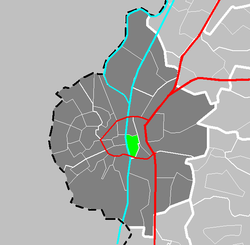Wyck, Maastricht
Appearance
Wyck | |
|---|---|
neighbourhood | |
 Location of Wyck in Maastricht | |
| Municipality | Maastricht |
| Province | Limburg |
| Country | Netherlands |
| Area | |
| • Total | 64 ha (158 acres) |
| Population | |
| • Total | 4,600 (Wyck-Céramique combined) |
Wyck (Dutch pronunciation: [ˈʋik]; Template:Lang-li [ˈwiːk˦]) is a neighbourhood in Maastricht, Netherlands comprising the eastern bank of the Meuse (Dutch: Maas) in the city's historic centre.
Areas
The neighbourhood consists of three distinct parts:
- Oud-Wyck ("Old Wyck"), comprising the oldest built-up area, until 1867 surrounded by Maastricht's Medieval city wall.
- Stationsbuurt ("Station Neighbourhood"), the area west of the railway and Maastricht railway station, predominantly dating from the 19th century.
- Céramique, on the former factory grounds of Société Céramique south of Old Wyck, redeveloped during the 1990s/2000s. The area consists mostly of new-built apartment blocks, designed by international architects, and some restored factory buildings. The Bonnefantenmuseum, designed by Aldo Rossi, is a major landmark along the Meuse river. Though sometimes seen as a neighbourhood in itself, Céramique is officially part of Wyck.
Notable features
- Beluga (restaurant)
- Bonnefantenmuseum
- Centre Céramique, Maastricht's main public library
Impressions
-
Oud-Wyck during the 1950s
-
Typical architecture of Oud-Wyck (national monument 27883)
-
Typical street in Oud-Wyck
-
Maastricht railway station
-
Intersection
-
Céramique: View onto the 1990s/2000s built apartment blocks and a theatre housed in an older building (centre)
-
Céramique: view of Avenue Céramique, Céramique's main thoroughfare
-
Céramique: view of Avenue Céramique into the opposite direction
-
Céramique: view of an apartment building typical of this section of Wyck










